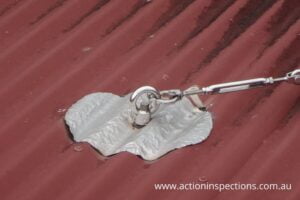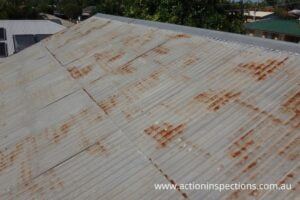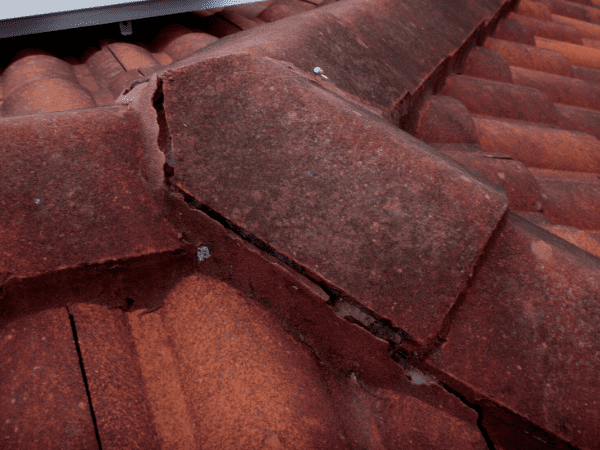Updated July 2024 by Andrew Mackintosh
A building inspection is an important step in the home purchasing process. As a prospective buyer, you should always have one completed before you make a purchase. A good inspection report will include a report on the condition of your roof – both inside and outside. So, what happens when that report comes back and the inspector has found roof damage? Is it a dealbreaker?
NOTE Action Property Inspections are specialists in pre-purchase building inspections in Brisbane. We do not offer Roof Inspections as a stand-alone service however all our pre-purchase building inspections include thorough exterior and interior roof inspections.
It doesn’t have to be. It’s essential to get to grips with what caused the damage, whether that issue is still present, and how bad it is. Is it low-level damage that requires a patch or a few replacement tiles? Or does the building need a brand-new roof?
In my experience, the asbestos roof is a deal breaker. The cost and logistics of removing an asbestos roof it eyewatering and if the property is old enough to have heritage listing, the process of replacing an asbestos roof can be a bureaucratic nightmare. Most roof types are susceptible to some kind of damage, whether it’s weather events or simple wear and tear. A few broken tiles aren’t a deal breaker but if they’ve been left that way for a prolonged period, water damage in the ceiling cavity or walls requires thorough investigation.
Obvious signs of roofing issues to look for at open inspections
The condition of the roof can impact the whole house. A brand-new renovation is exciting but worthless if the roof is leaking and letting moisture and mould into those brand-new kitchen cupboards. Look for:
- Rust on the roof
- Missing or cracked tiles
- Watermarks down the walls
- Musty or damp smell in the house
- Watermarks in the brickwork and “bleeding” down the walls
- Sagging ceilings or waves in the ceiling.
Less obvious signs
During a pre-purchase building inspection, where it’s safe to do so, a professional inspector will get up in your ceiling, take photos, and let you know straight away about more than just cosmetic issues. Andrew from Action Property Inspections has over 37 years of experience in the industry. He will look at:
- The construction of the roof and if it is up to Australian Standards
- Issues with flashing or lack of flashing (learn more about flashing here)
- The material the roofing is made of
- Pointing damage
- Loose valley tiles
- Poorly sealed ridge capping
- If there is decay in the struts and frame of the ceiling (learn more about water damage in ceilings)
- If the roof has been replaced, but the damage from a leak has not
- The quality and state of insulation
- The state of gutters, downpipes and drainage
- If the sarking barrier is there and if it’s to code
- If the apron flashing is to the wall and provides weatherproof protection
- Check the flashings and ensure they are compliant.
Want to know more? Read our Buyer’s Guide to Roof Problems in Brisbane.
What are the different roof types and what problems do they pose?
- Terracotta roof tiles – individual tile breakage causing roof leaks – relatively simple to replace, requires periodic sealant
- Concrete roof tiles – individual tile breakage – relatively simple to replace, susceptible to concrete degradation over time.
- Colorbond sheeting – generally good, if correctly fitted and sealed
- Zincalume sheeting – generally good if correctly fitted and sealed
- Asbestos sheeting and tiles – poses serious health hazard, requires thorough sealing or full replacement. Replacement is expensive due to costs of asbestos removal and disposal.
- Corrugated iron – prone to rust and multiple small holes. Susceptible to poor sealing allowing for pest infestation.
- Slate roofing – individual tile breakage, expensive and relatively difficult to replace due to rarity
- Shingle roofing – individual tile breakage, poor sealing. These may be difficult to replace as they peaked in popularity in the 1980s
Cost considerations
- If the roof is slate, shingle or asbestos, be aware and check that the house is not heritage listed. Some rules control what repairs can be done on heritage-listed roofing. Any issues with this variety of roofing usually equals big dollars. Asbestos is also something to be wary of for houses made of fibre cement cladding or timber.
- Roof tiles, typically made from terracotta or concrete, are great for insulation and can be replaced easily. However, they tend to wear in the harsh Queensland sun. They can also be dislodged without much effort, allowing moisture and mould into the ceiling and walls of the house.
- Corrugated iron is “old technology” so is rarely used these days. If your new home has a corrogated iron roof, chances are you’re up for a replacement soon.
- Boutique roofing including thatching on “Bali huts” and multilayer insulated patio roof panels pose their own problems and can be cost prohibitive to repair.
Metal Roof Issues
Roof pitch
One of the common problems seen on a regular basis is the use of the wrong type of roof sheeting used  on a low pitched roof. Learn more about roof pitch here. For example on a recent building inspection in the Brisbane suburb of Carina, a previous building inspector noted that the roof sheeting was in good condition however there was some evidence of minor roof leaks. When I went out to undertake the reinspection it was clearly evident that the wrong roof sheeting had been installed in this situation. The entire rear extension had been covered with corrugated Zincalume roof sheeting. As this particular roof was of a near flat roof design most builders would have utilised clip lock roof sheeting or similar with its high ridge profiles and its ability to be modified easily to provide a waterproof seal. Whilst the Zincalume roof sheeting was in good condition it was clearly not suitable in this application. Unfortunately time and time again we see the standard corrugated roof profile used in low pitch roof designs showing the ever present signs of internal water leakage.
on a low pitched roof. Learn more about roof pitch here. For example on a recent building inspection in the Brisbane suburb of Carina, a previous building inspector noted that the roof sheeting was in good condition however there was some evidence of minor roof leaks. When I went out to undertake the reinspection it was clearly evident that the wrong roof sheeting had been installed in this situation. The entire rear extension had been covered with corrugated Zincalume roof sheeting. As this particular roof was of a near flat roof design most builders would have utilised clip lock roof sheeting or similar with its high ridge profiles and its ability to be modified easily to provide a waterproof seal. Whilst the Zincalume roof sheeting was in good condition it was clearly not suitable in this application. Unfortunately time and time again we see the standard corrugated roof profile used in low pitch roof designs showing the ever present signs of internal water leakage.
Over tighten screws
Another common problem is where the home renovator is overzealous in screwing down the roof sheets, distorting and splitting the washers under the head of the screw and in some cases actually distorting the roof sheeting, subsequently contributing to future water leaks.
Galvanic corrosion
When you have installed roof sheeting is imperative that you use the correct flashing to prevent what is known as galvanic corrosion. Not all metals are compatible. If you install two incompatible metals corrosion will result. On a recent inspection in the Brisbane suburb of Chermside substantial corrosion was noted to the roof sheeting where they used lead flashing under the gables. Lead cannot be used on a Zincalume roof as it will cause premature corrosion.
Scratched paint finish
Quite often during the construction of the house scratches occur within the metal roof sheeting.  Ideally these scratches need to be touched up to help prevent premature corrosion. A paint pen ideally supplied by the Manufacturer of the roof sheeting in an identical colour is a good way of touching up minor scratches. Some manufacturers supply aerosol paints for touch ups however with the progression of time areas patched with aerosol paint tends to fade much quicker than the original paint. This leads to very unsightly patches on the roof. Some scratches during construction are inevitable however with a little care the level of damage should be minimal.
Ideally these scratches need to be touched up to help prevent premature corrosion. A paint pen ideally supplied by the Manufacturer of the roof sheeting in an identical colour is a good way of touching up minor scratches. Some manufacturers supply aerosol paints for touch ups however with the progression of time areas patched with aerosol paint tends to fade much quicker than the original paint. This leads to very unsightly patches on the roof. Some scratches during construction are inevitable however with a little care the level of damage should be minimal.
Walking on the roof
Many homeowners will jump on their roof to retrieve the kid’s football or to clean out the gutters. Unfortunately, sometimes they are inadvertently causing damage to their metal roof. Walking in the centre of a corrugated roof sheet particularly a thin gauge roof sheet can cause buckling and even cracking of the metal that could contribute to roof leaks. On a Klip Lok roof, walking on the flat of the roof sheet can stretch the metal creating slight hollows that hold water after rain periods. Retained moisture on the roof sheeting promotes corrosion and eventually excessive corrosion can lead to rust penetration holes and further water leaks. Learning where it is safe to walk on a metal roof will help prevent future damage.
What You Need To Know
Brisbane’s roofs have a lot to contend with, from high winds and storms, as well as high temperatures, surrounding trees and possums. We will look at both the outside and inside of a roof to detect if there is any damage. The inspector will check the structure and roof space, looking for moisture, roof leaks and general damp issues as well as checking for signs of structural failure and incorrect roof construction.
A minor issue is classed as a simple repair and would be dislodging roof tiles, flashing repairs, and sealing around vent penetrations. These are easily affordable, but they can spiral into serious structural problems if these issues are ignored. The bigger the issue, the more expensive the repairs, especially where there is damage to joists, trusses, or beams etc. If you have a repair budget to work with, then none of these is a dealbreaker. You can fix rusty roofing or minor damage to roof framing, but be careful as it is easy to add thousands of dollars to your renovation budget. For example, a full-roof replacement is certainly not a cost you want to incur.
Depending on what the inspector has found during your roof inspection, you may want to enlist a professional roofer to provide a detailed quote. This will give you a clear idea of the potential repair or replacement costs. The critical thing to understand is that the building inspection report is the best way for you to renegotiate the best possible purchase price. So, while you may have to deal with repair issues, it might be worth your while if you can negotiate a great purchase price.
We’re Thorough
Real estate agents are happy to take you to an open house inspection, show you around, highlight all the fabulous selling points of the property. But there is a good reason why some estate agents hate it when Action Property Inspections enter the picture. We have a dependable reputation in the business for being incredibly thorough, and we back every fault we find with hard evidence. If you want an inspection company that gets the job done well, you want Action Property Inspections.

